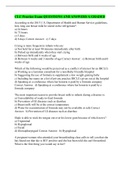Summary
Summary International Law Malcolm D. Evans Fifth Edition ISBN: 978-0-19-879183-6
- Course
- Institution
- Book
Summary for the book Malcolm D. Evans Fifth Edition ISBN: 978-0-19-879183-6 This summary contains the following chapters CHAPTER 1 – A short history of international law CHAPTER 4 – The theory and reality of the sources of international law CHAPTER 9 – The individual and the internation...
[Show more]













